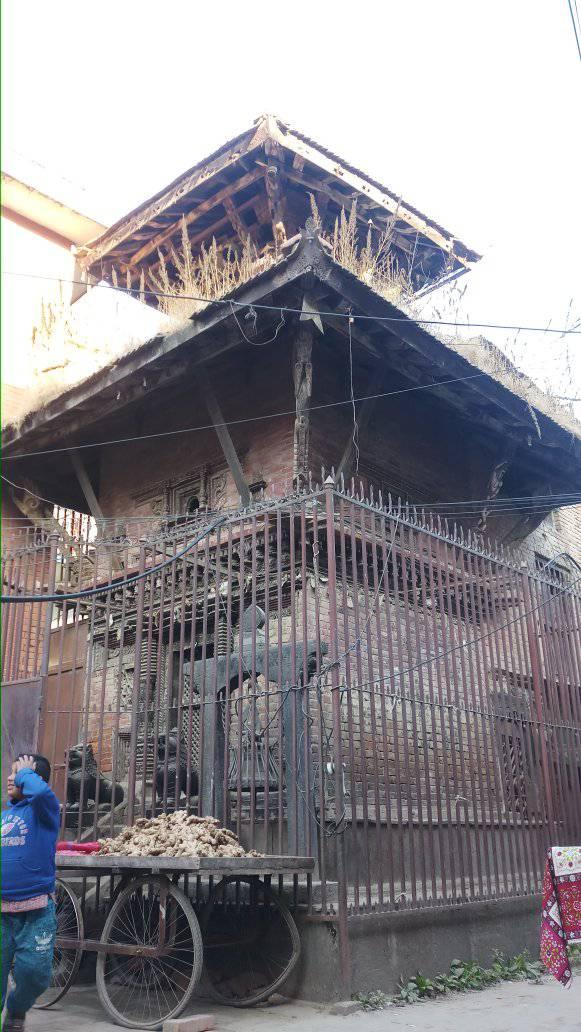Dattatreya Temple of Patan that almost no one knows about

By Aashish Mishra
Lalitpur, Dec : Suresh Shakya has been a tourist guide in Patan for the better part of the last two decades. As a guide, he has studied a lot about the temples and monuments in and around Patan Durbar Square in order to accurately explain their history and significance to the foreigners that come to the city.
Owing to his profession, Shakya feels that he knows the inner alleys and structures of Lalitpur like the back of his hand. But he was shocked to hear that there was a temple dedicated to Dattatreya near Wolkhu in the street in front of the Bhimsen Temple of Mangalbazaar. “There is only one Dattatreya and that is in Bhaktapur, isn’t it?” he questioned.
Similarly, Resham Maya Dongol walks every morning from her home at Shankhamul to worship the shrines from Chyasal to Lagankhel. On her way, she stops at Tilakwo and offers rice to a two-tiered pagoda temple. She has always thought the temple to be that of Shiva because the idol inside has dreadlocks (Jatta) like Lord Mahadev and was surprised to learn that the idol was actually that of Dattatreya.
“Wow,” was all she could exclaim.
Not many people seem to know that Patan too has a temple dedicated to Dattatreya, the symbolic name indicating the syncretic deity, the union of Brahma, Vishnu and Shiva in one form. The structure of and carvings on the temple indicate that it was built in the late 17th century and the design demonstrates influences from, or even competes with, the larger Dattatreya Temple of Bhaktapur built in the 15th century, said Bharat Maharjan, a scholar of Nepal Bhasa and Newa culture.
“Patan’s Dattatreya, like its Bhaktapur counterpart, faces west and both are built in the pagoda style,” he said, adding, “Rather than a simple coincidence, this perhaps demonstrates the intermingling of culture that existed between the two cities (Patan and Bhaktapur) or the [family] relations the temple’s patron clan may have had with Bhaktapur.”
The patron clan Maharjan is referring to are the Puri families who live next to the temple. They are the ones responsible for conducting regular service of the temple and according to Tilakwo locals, the temple is under the authority of their private Guthi. A few residents The Rising Nepal talked to claimed that the temple was constructed by the ancestors of these Puris.
Maharjan also found the assumption plausible and informed that the Malla kings were known for building special Math (shrine) and settling members of the Dashnami sect, an order of 10 groups of which Puri is one, around them.
Members of the concerned Puri family could not be directly contacted for this news.
“The temple, while open to the public, has always been considered under the ownership of the Puris,” Sanubhai Maharjan, a resident of Bhau Nani, Lalitpur, said. The 93-year-old Maharjan’s mother hailed from Walkhu, a few metres east of Tilakwo, and he remembers his childhood days spent playing hide and seek around the temple with his cousins.
“No one knew that the temple was dedicated to Dattatreya back then too,” he recounted. “Perhaps that is why it has not been conserved.”
According to Sanubhai Maharjan and the locals, almost all of the struts of the temple have been stolen along with a part of the main door’s frame. Many of the tiles covering the temple’s roofs have fallen off and the walls are cracked. The 2015 earthquake has caused the whole building to tilt visibly to the south. The stone statue of the Garud erected on a pillar in front of the temple was also stolen a few years ago and has been replaced with a replica.
“People do not recognise this temple and hence, do not care for it,” Sanubhai said. “Why would anyone think of preserving the Dattatreya Temple of Patan when they do not even know that there is a Dattatreya Temple in Patan in the first place?”
Sunday, Yomari Punhi, is also considered the birthday of Guru Dattatreya. But you would not know it by looking at the temple which lies in as dilapidated state as ever.
Recent News

Do not make expressions casting dout on election: EC
14 Apr, 2022
CM Bhatta says may New Year 2079 BS inspire positive thinking
14 Apr, 2022
Three new cases, 44 recoveries in 24 hours
14 Apr, 2022
689 climbers of 84 teams so far acquire permits for climbing various peaks this spring season
14 Apr, 2022
How the rising cost of living crisis is impacting Nepal
14 Apr, 2022
US military confirms an interstellar meteor collided with Earth
14 Apr, 2022
Valneva Covid vaccine approved for use in UK
14 Apr, 2022
Chair Prachanda highlights need of unity among Maoist, Communist forces
14 Apr, 2022
Ranbir Kapoor and Alia Bhatt: Bollywood toasts star couple on wedding
14 Apr, 2022
President Bhandari confers decorations (Photo Feature)
14 Apr, 2022









